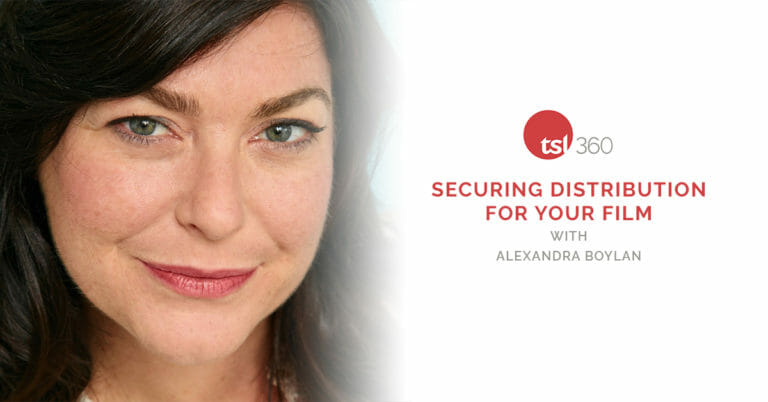By Valerie Kalfrin · March 1, 2019

If you finish a film but no one sees it, do you make any money? That’s a question that producer, writer, and actor Alexandra Boylan encourages filmmakers to consider.
Boylan has sold three features (Home Sweet Home, Catching Faith, and Wish for Christmas) to major distribution companies such as Image Entertainment and Universal Pictures Home Entertainment. The awards and recognition of film festival don’t translate into sales unless your film makes it into Sundance, Tribeca, or SXSW, she says in her new TSL 360 video.
“It’s going to cost you a lot of money to submit your films to all the film festivals,” Boylan said, recounting how she spent $2,000 to submit the 2012 thriller Home Sweet Home to 20 festivals—and it wasn’t accepted into any. “People ask me if I’m going to submit my film to a film festival, and I’m like, ‘No way.’ When I’m done paying for that movie, the next step is earning money off my movie.”
We often talk about the creative side of the craft, but if you want your stories out in the world, you need to get noticed. Boylan shared some sobering statistics. In 2016, the Sundance Film Festival received more than 4,000 submissions and selected 120 feature films; only about 3 percent got distribution. That same year, the Tribeca Film Festival also received more than 4,000 submissions and selected about 70 films for competition; 30 received distribution.
“If you’d like to go to a film festival, I’m not trying to sway you against it. I just like to ask people what is the outcome that you’re hoping for,” Boylan said. Clout and accolades are “awesome,” but if you’re looking to sell, consider where you’ll have the best chance.
“Genre films are the number-one sellers. Horror movies are huge sellers. But that’s not necessarily a movie that’s going to go to Sundance,” she said.
Here, Boylan breaks down why you want a distributor or a sales agent—and what you’ll need to attract one. Hear more detailed advice and examples from her with a TSL 360 membership (there’s a free 3-day trial). TSL 360 also grants you access to dozens of masterclasses, interviews, and lectures from Academy Award-winning screenwriters, Emmy-winning TV writers, producers, agents, and major studio executives.
You don’t need a distribution company or a sales agent to put your movie on Amazon.com or iTunes, provided such a streaming outlet pays you an upfront fee for your film. Don’t give your movie away for free, Boylan said.
You’ll make more money with a DVD sold through a big-box store (a $9.99 or $12.99 purchase) versus a $2.99 download or VOD, Boylan said. A distribution company has the resources to package and ship your film.
“Walmart is the number-one selling big-box store in America, so if you want the demographic that’s buying DVDs, you want to go to Walmart,” Boylan said. “If Walmart comes to you as an independent filmmaker and says, ‘I want to buy your movie,’ and they order 30,000 DVDs, that’s on you. You have to package 30,000 DVDs and ship 30,000 DVDs. And Walmart has a buyback deal. So if your movie does not sell, you have to buy back your movie from Walmart.”
Sales agents have contacts with distribution companies. These agents only make money when you make money (again, don’t pay anyone upfront). They charge between 10 percent and 30 percent for the sale of the film.
For Home Sweet Home, Boylan’s sales agent took 30 percent of the sale, which ended up being twice the film’s budget of about $10,000. That satisfied Boylan, who turned a profit. “Seventy percent of something was better than nothing,” she said.
Boylan appeared as an actress in her friend Evan Glodell’s 2011 action/drama Bellflower, which was nominated for an audience award at SXSW and placed fourth in an Indiewire Critics’ Poll. Bellflower went to Sundance and triggered a bidding war because “it was already being positioned in the market to sell,” Boylan said. Glodell’s sales agent took only 10 percent in that case.
A distributor or a sales agent naturally wants to know you have a finished film, but they’re unlikely to watch it because of the volume of material they buy and sell. Instead, they look at the poster for a sense of the genre and concept, Boylan said.
You may have a friend skilled in Photoshop who can design something nice, but “poster companies know what’s selling in the marketplace. They’re going to American Film Market,” where distributors choose based on the poster alone, she said.
The home-viewing audience chooses what to watch the same way, especially if there are no big-named stars to highlight. Even if there are known names in the cast, sometimes distributors think the concept is a stronger draw.
Boylan credits Dog & Pony Creative, a graphic design company she met at a Women In Film event, with creating the poster that scored the sale and distribution of Home Sweet Home. (The distributor developed another poster for the DVD cover.)
Both designs sold the concept: an armed young woman facing invaders alone at a backlit home.
Although Bill Engvall (Last Man Standing) costars in Boylan’s 2015 family drama Catching Faith, the distributor again chose a poster image that distilled the concept: a football player taking a knee in prayer.
“Think of how small thumbnails are on Netflix or Redbox,” she said. “Without a good poster, no one’s going to click on it.”
The 11 Fundamental Questions with Aaron Mendelsohn
7 Strategies for ‘Producing People’ and Being a Great Producer with Kristen Murtha
8 Keys to Unlocking Hollywood Gatekeepers from Producer Sandra Leviton
4 Top Reps Reveal How to Get an Agent or Manager
5 Ways to Break In as a TV Writer

 Valerie Kalfrin is an award-winning crime journalist who now dives into fictional mayhem as an author (Quicklet on The Closer: Season 1), essayist, film critic, screenwriter, and emerging script consultant. She also writes for The Guardian, Bright Wall Dark Room, ScreenCraft, Hazlitt, Signature, and the blog for Final Draft, the top-rated screenwriting software used by the filmmaking industry. A member of Screenwriters of Tomorrow, she’s collaborated on short films and features, and she’s affiliated with the Tampa Bay Film Society. She lives in Florida. Find her online at valeriekalfrin.com.
Valerie Kalfrin is an award-winning crime journalist who now dives into fictional mayhem as an author (Quicklet on The Closer: Season 1), essayist, film critic, screenwriter, and emerging script consultant. She also writes for The Guardian, Bright Wall Dark Room, ScreenCraft, Hazlitt, Signature, and the blog for Final Draft, the top-rated screenwriting software used by the filmmaking industry. A member of Screenwriters of Tomorrow, she’s collaborated on short films and features, and she’s affiliated with the Tampa Bay Film Society. She lives in Florida. Find her online at valeriekalfrin.com.
For all the latest from The Script Lab, be sure to follow us on Twitter, Facebook, and Instagram.